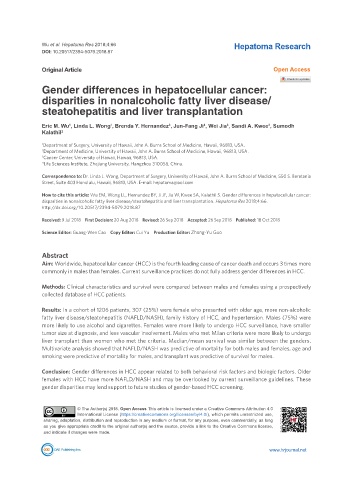Page 736 - Read Online
P. 736
Wu et al. Hepatoma Res 2018;4:66 Hepatoma Research
DOI: 10.20517/2394-5079.2018.87
Original Article Open Access
Gender differences in hepatocellular cancer:
disparities in nonalcoholic fatty liver disease/
steatohepatitis and liver transplantation
3
4
3
3
Eric M. Wu , Linda L. Wong , Brenda Y. Hernandez , Jun-Fang Ji , Wei Jia , Sandi A. Kwee , Sumodh
1
1
Kalathil 2
1 Department of Surgery, University of Hawaii, John A. Burns School of Medicine, Hawaii, 96813, USA.
2 Department of Medicine, University of Hawaii, John A. Burns School of Medicine, Hawaii, 96813, USA.
3 Cancer Center, University of Hawaii, Hawaii, 96813, USA.
4 Life Sciences Institute, Zhejiang University, Hangzhou 310058, China.
Correspondence to: Dr. Linda L. Wong, Department of Surgery, University of Hawaii, John A. Burns School of Medicine, 550 S. Beretania
Street, Suite 403 Honolulu, Hawaii, 96813, USA. E-mail: hepatoma@aol.com
How to cite this article: Wu EM, Wong LL, Hernandez BY, Ji JF, Jia W, Kwee SA, Kalathil S. Gender differences in hepatocellular cancer:
disparities in nonalcoholic fatty liver disease/steatohepatitis and liver transplantation. Hepatoma Res 2018;4:66.
http://dx.doi.org/10.20517/2394-5079.2018.87
Received: 9 Jul 2018 First Decision: 20 Aug 2018 Revised: 26 Sep 2018 Accepted: 26 Sep 2018 Published: 18 Oct 2018
Science Editor: Guang-Wen Cao Copy Editor: Cui Yu Production Editor: Zhong-Yu Guo
Abstract
Aim: Worldwide, hepatocellular cancer (HCC) is the fourth leading cause of cancer death and occurs 3 times more
commonly in males than females. Current surveillance practices do not fully address gender differences in HCC.
Methods: Clinical characteristics and survival were compared between males and females using a prospectively
collected database of HCC patients.
Results: In a cohort of 1206 patients, 307 (25%) were female who presented with older age, more non-alcoholic
fatty liver disease/steatohepatitis (NAFLD/NASH), family history of HCC, and hypertension. Males (75%) were
more likely to use alcohol and cigarettes. Females were more likely to undergo HCC surveillance, have smaller
tumor size at diagnosis, and less vascular involvement. Males who met Milan criteria were more likely to undergo
liver transplant than women who met the criteria. Median/mean survival was similar between the genders.
Multivariate analysis showed that NAFLD/NASH was predictive of mortality for both males and females, age and
smoking were predictive of mortality for males, and transplant was predictive of survival for males.
Conclusion: Gender differences in HCC appear related to both behavioral risk factors and biologic factors. Older
females with HCC have more NAFLD/NASH and may be overlooked by current surveillance guidelines. These
gender disparities may lend support to future studies of gender-based HCC screening.
© The Author(s) 2018. Open Access This article is licensed under a Creative Commons Attribution 4.0
International License (https://creativecommons.org/licenses/by/4.0/), which permits unrestricted use,
sharing, adaptation, distribution and reproduction in any medium or format, for any purpose, even commercially, as long
as you give appropriate credit to the original author(s) and the source, provide a link to the Creative Commons license,
and indicate if changes were made.
www.hrjournal.net

